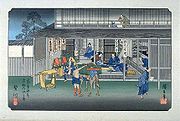
Niekawa-juku
Encyclopedia

69 Stations of the Nakasendo
The are the rest areas along the Nakasendō, which ran from Nihonbashi in Edo to Sanjō Ōhashi in Kyoto. The route stretched approximately and was an alternate trade route to the Tōkaidō.-Stations of the Nakasendō:...
of the Nakasendō
Nakasendo
The , also called the , was one of the five routes of the Edo period, and one of the two that connected Edo to Kyoto in Japan. There were 69 stations between Edo and Kyoto, crossing through Musashi, Kōzuke, Shinano, Mino and Ōmi provinces...
. It is located in the present-day city of Shiojiri
Shiojiri, Nagano
is a city located in Nagano, Japan. Its name literally means "the end of salt".-History:Municipal Area Changes* April 1, 1927-The village of Shiojiri gained town status....
, Nagano Prefecture
Nagano Prefecture
is a prefecture of Japan located in the Chūbu region of the island of Honshū. The capital is the city of Nagano.- History :Nagano was formerly known as the province of Shinano...
, Japan
Japan
Japan is an island nation in East Asia. Located in the Pacific Ocean, it lies to the east of the Sea of Japan, China, North Korea, South Korea and Russia, stretching from the Sea of Okhotsk in the north to the East China Sea and Taiwan in the south...
.
History
Niekawa was originally written as 熱川 (niekawa, "warm river") because there were onsenOnsen
An is a term for hot springs in the Japanese language, though the term is often used to describe the bathing facilities and inns around the hot springs. As a volcanically active country, Japan has thousands of onsen scattered along its length and breadth...
in the area, which made the river warm. However, the kanji
Kanji
Kanji are the adopted logographic Chinese characters hanzi that are used in the modern Japanese writing system along with hiragana , katakana , Indo Arabic numerals, and the occasional use of the Latin alphabet...
were eventually changed to the ones used today.
Originally built in the Tenbun period
Tenbun
, also known as Tembun or Temmon, was a after Kyōroku and before Kōji. This period spanned the years from July 1532 through October 1555. The reigning emperor was .-Change of era:...
, it was the first of 11 resting spots along the Kisoji
Kisoji
The was an old trade route in the Kiso Valley that stretched from Niekawa-juku in Nagano Prefecture to Magome-juku in Gifu Prefecture. There were eleven resting spots along the route, all of which became part of the Nakasendō when it was established...
(木曽路), which stretched to modern-day Nakatsugawa
Nakatsugawa, Gifu
is a city located in the Tōnō region of Gifu Prefecture, Japan. The city was founded on April 1, 1952.-History:During Japan's Edo period, Nakatsugawa was a post town, known as Nakatsugawa-juku, one of the 69 Stations of the Nakasendō along the Nakasendō. The travel route ran from the Nihonbashi in...
, Gifu Prefecture
Gifu Prefecture
is a prefecture located in the Chūbu region of central Japan. Its capital is the city of Gifu.Located in the center of Japan, it has long played an important part as the crossroads of Japan, connecting the east to the west through such routes as the Nakasendō...
. It also marked the dividing point between the Owari Han and the Matsumoto han. It became part of the Nakasendō during the Edo period
Edo period
The , or , is a division of Japanese history which was ruled by the shoguns of the Tokugawa family, running from 1603 to 1868. The political entity of this period was the Tokugawa shogunate....
.
Neighboring post towns
Nakasendō- Motoyama-jukuMotoyama-jukuwas the thirty-second of the sixty-nine stations of the Nakasendō. It is located in the central part of the present-day city of Shiojiri, Nagano Prefecture, Japan.-History:...
- Niekawa-juku - Narai-jukuNarai-jukuwas the thirty-fourth of the sixty-nine stations of the Nakasendō, as well as the second of eleven stations along the Kisoji. It is located in the present-day city of Shiojiri, Nagano Prefecture, Japan.-History:...
Kisoji
- Niekawa-juku (starting location) - Narai-jukuNarai-jukuwas the thirty-fourth of the sixty-nine stations of the Nakasendō, as well as the second of eleven stations along the Kisoji. It is located in the present-day city of Shiojiri, Nagano Prefecture, Japan.-History:...

